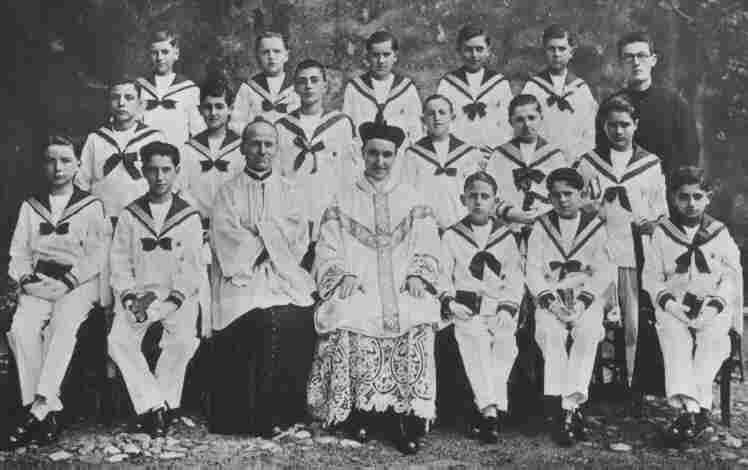
French Renewal/Confirmation Suits

Figure 1.--These French boys at a boarding school in the mid-1930s are renewing their First Communion vows. We at first thought this was the boys' Confirmation. A French reader tells us, "French boys, however, do their First Communion at about age 11-12, much later than in America. The white armband is worn only for communion. For the Confirmation the children are not specialy dressed. Most have a bow on his sleeve, just like First Communion. Their mothers will carefully put those away after the service. Notice they are holding their Hymnals. They look to be 12-13 years of age. One can see two priests with the boys here. If this was a comfirmation one would have seen a bishop."
|
Some churches also make a major event out of the child' renewing his vows. HBC has less information on this event than First Communnion. There are confirmation ceremonies in both Catholic and Protestant churches. Generally speaking confirmation is more important in Protestant than Catholic churches. France is of course a primarily Catholic country. A French contributor has provided information about a Catholic boarding school during the mid-1930s had the boys (les renouvelants) dress in emaculate white sailor suits to renew their vows. The sailor suits were probably also worn for First Communion. The sailor suits are trimed in blue, but insread of three white stripes as is traditional in England (for Nelson's three great victories over the French), have red stripes. This presumably mirrors the uniform worn by the French Navy during the 1930s. They all wear black oxfords rather than white shoes--presumably an economy measure. I do not know how common this was, but have some reports from Spain that boys also wear white sailor suits for First Communion. We are unsure as to how common sailor suits were for confirmation in other countries.
The Celebration
Some churches also make a major event out of the child' renewing his vows. HBC has less information on this event than First Communnion. There are confirmation ceremonies in both Catholic and Protestant churches. Generally speaking confirmation is more important in Protestant than Catholic churches. France is of course a primarily Catholic country. For the confirmation, the "confirmé" need a " parrain" (a Godfather). The sacrement is give only by a bishop. Confirmation in France is not generally considered to be as important a ceremony as First Communion. They look to be 12-13 years of age. One can see two priests with the boys here. If this was a comfirmation one would have seen a bishop.
Terminology
There are several ceremonies in France involving children and Communion. The French term for Confirmation is also " Confirmation ". In the past and today, confirmation is alo called " le renouvellement ". This term is used inside of the church. Another term that is used is " Communion solennel" .
Age
The French Catholic First Communion normally takes place at about age 11-12. This is quite a bit later than is the case in America (figure 1). Confirmation is normally about 2-3 years later or about 14-16 years of age.
Chronology
A French contributor has provided information about a Catholic boarding school during the mid-1930s had the boys (les renouvelants) dress in emaculate white sailor suits to renew their vows. The white sailoe suits were worn with white gloves. We are not sure how common sailor suits were for this ceremony or how fashion trends for Confirmation suits varied over time.
The sailor suits seen here were for First Communion. The sailor suits here are trimed in blue, but instead of three white stripes as is traditional in England (for Nelson's three great victories over the French), have red stripes. This presumably mirrors the uniform worn by the French Navy during the 1930s. They all wear black oxfords rather than white shoes--presumably an economy measure. I do not know how common this was, but have some reports from Spain that boys also wear white sailor suits for First Communion. We are unsureas to how common sailor suits were for Confirmation in other countries. Unlike for First Communion, there was no special styles like sailor sits or cassocks that were worn for Confirmation. Rather boys wore their bet uits, often suits purchased for the occassoin. Often they were more mature styled suits than the uitsand ther outfits that the boy had been wearing. Boys did not wear arm bands for their confirmation. Thus we know tht the imag here is a solennel (fist) communion and not a confirmation because the armband is only worn for
communion.
HBC

Navigate the Boys' Historical Clothing Web Site religious pages:
[Return to the Main Confirmation page]
[Return to the Main Communion page]
[First Communion]
[Ring bearer]
[Victorian wedding]
Navigate the Historic Boys' Clothing Web Site:
[Introduction]
[Activities]
[Biographies]
[Chronology]
[Clothing styles]
[Countries]
[Topics]
[Bibliographies]
[Contributions]
[FAQs]
[Glossaries]
[Satellite sites]
[Tools]
[Boys' Clothing Home]
Navigate the Historic Boys' Clothing Web chronological pages:
[The 1920s]
[The 1930s]
[The 1940s]
[The 1950s]
[The 1960s]
[The 1970s]
Navigate the Historic Boys' Clothing Web style pages:
[Short pants suits]
[Blazers]
[Jackets]
[Kilts]
[Sailor suits]
[Sailor hats]
[Ring bearer/page costumes]
[Shortalls]
Created: November 16, 1999
Last edited: June 6, 2004



